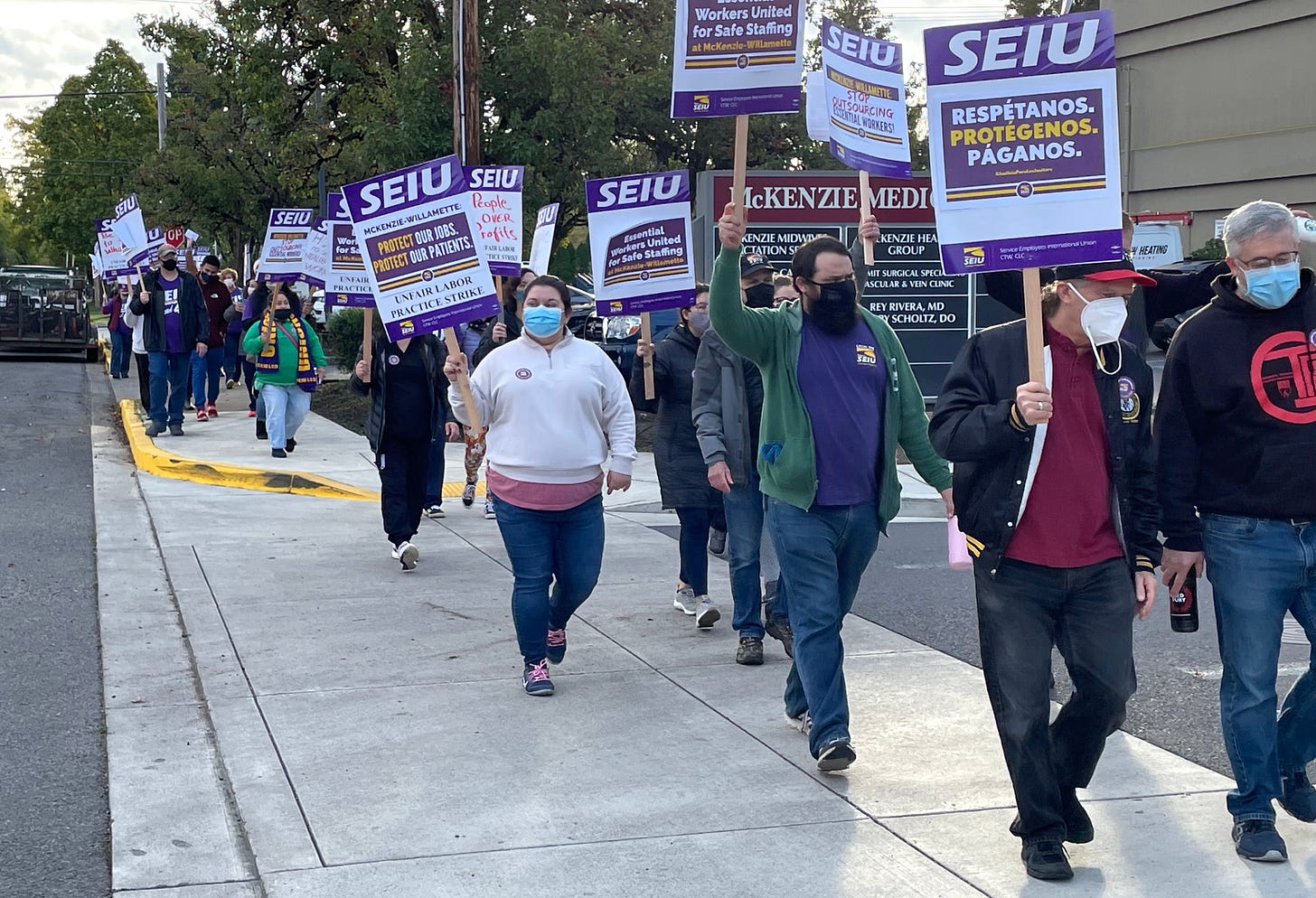#Striketober is Just the Beginning
The tide is changing in the labor movement. Rising income inequality, general frustration with working conditions, and a prevailing sense of powerlessness has pushed workers to the edge.
At 6 AM on October 5th, a group of 400 certified nursing assistants, janitors, and dietary workers walked off the job at McKenzie-Willamette Medical Center in Springfield, Oregon to protest low pay and outsourcing. You could sense the unmistakable mix of fear and excitement that comes in these moments. In groups of two or three, workers walked through the main entrance of the hospital to join their colleagues on the strike line. Cheers erupted from the crowd with each new arrival while TV cameras trained on purple signs that read, “If we’re out here, there’s something wrong in there.”
A strike is an act of desperation, a last resort for people pushed so far they’re willing to forgo their paychecks, risk their jobs, and strain relationships in order to force change. Nobody wants to do it. But working people all across the country are taking action at a scale we haven’t seen in decades.
Dubbed #Striketober by the media, unions representing more than 100,000 people voted to authorize strikes between October 3rd and 14th, a span of just 11 days. These include the workers at McKenzie-Willamette, as well as 10,000 John Deere employees, 60,000 members of the International Alliance of Theatrical Stage Employees, and 24,000 Kaiser Permanente workers, including 3,400 nurses in Oregon. Frustration with inadequate pay, support, and flexibility has gone beyond stopping work through strikes. Jobs data released this month revealed record numbers of people quitting their jobs.
This isn’t just a unique moment in time or even a side effect of the COVID-19 pandemic. We are seeing the collision of decades-long trends that have pushed working people to the brink. Oregon’s long-term care industry provides a clear illustration of what’s going on.
Back in early 2020, pre-pandemic, your average nursing home in Oregon paid new workers $12, $13 or maybe $14 per hour. Staffing ratios, which are set by law, were widely viewed by workers as insufficient. Turnover was high and training regimens were weak. When COVID-19 hit, it hit hard.
New rules requiring workers to quarantine when exposed to the disease became a scheduling nightmare in an industry where short staffing was common. Fear of the virus ran into the reality that many homes paid poverty wages, leading people to decide that working in long-term care simply wasn’t worth it. PPE reserves and other disaster preparedness measures cost money, so it’s not at all surprising that most for-profit nursing homes didn’t have those things in place. Across the board, the industry was not ready. The results were deadly. In the first four months of the pandemic, 6 in 10 COVID deaths in Oregon occured in nursing homes.
I’ve spoken with many long-term care workers over the last year and a half, and they all say these conditions have left them physically and emotionally exhausted. Across many industries, stagnant wages, shareholder-driven “lean” operations, and profit-motivated “just in time” logistics have created work environments that are not sustainable. People have been pushed so far they are willing to take that final desperate act of going on strike to move the pendulum of power back in their direction. COVID-19 was the event that pushed us over the edge, but #Striketober is decades of correction all happening at once.
I believe we’re just getting started. In our union, the response to the challenges above led to organizing on a level we haven’t seen in years. In 2021, nursing home contract negotiations led to standard-setting wages. In some cases, raising the base pay by as much as 30%. At a non-union home in Springfield, just down the street from the McKenzie-Willamette Medical Center, a group of workers struck for recognition, an extremely bold tactic where a strike—without the protection of a union—is used in the effort to win a new union. Perhaps the most predictive data point we have to suggest this is just the beginning is that SEIU 503 has fielded more than 200 requests this year for information from non-union long-term care workers who are interested in changing the conditions at their workplaces.
Interest in unionizing is popping up all across the country, from Starbucks workers in Buffalo to undergraduate student workers in Ohio and members of The National Women's Soccer League Players Association joining the AFL-CIO. The tide is changing in the labor movement. Rising income inequality, general frustration with working conditions, and a prevailing sense of powerlessness among workers is reaching a point where we may overcome the union busting tactics responsible for the decline in union membership over the last 40 years.
When Halloween passes, #Striketober will still be going and the tide will keep turning. America’s workers are done accepting labor practices that place profits above people.
Melissa Unger is the executive director of SEIU 503, Oregon’s care provider and public services worker union, representing 72,000 people in Oregon.




